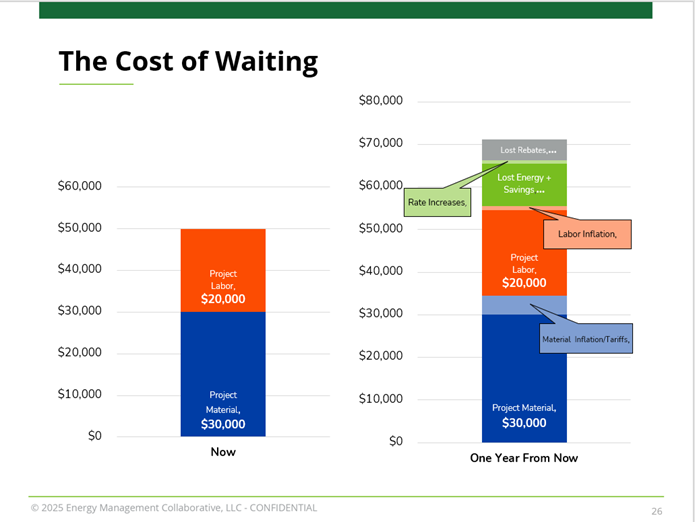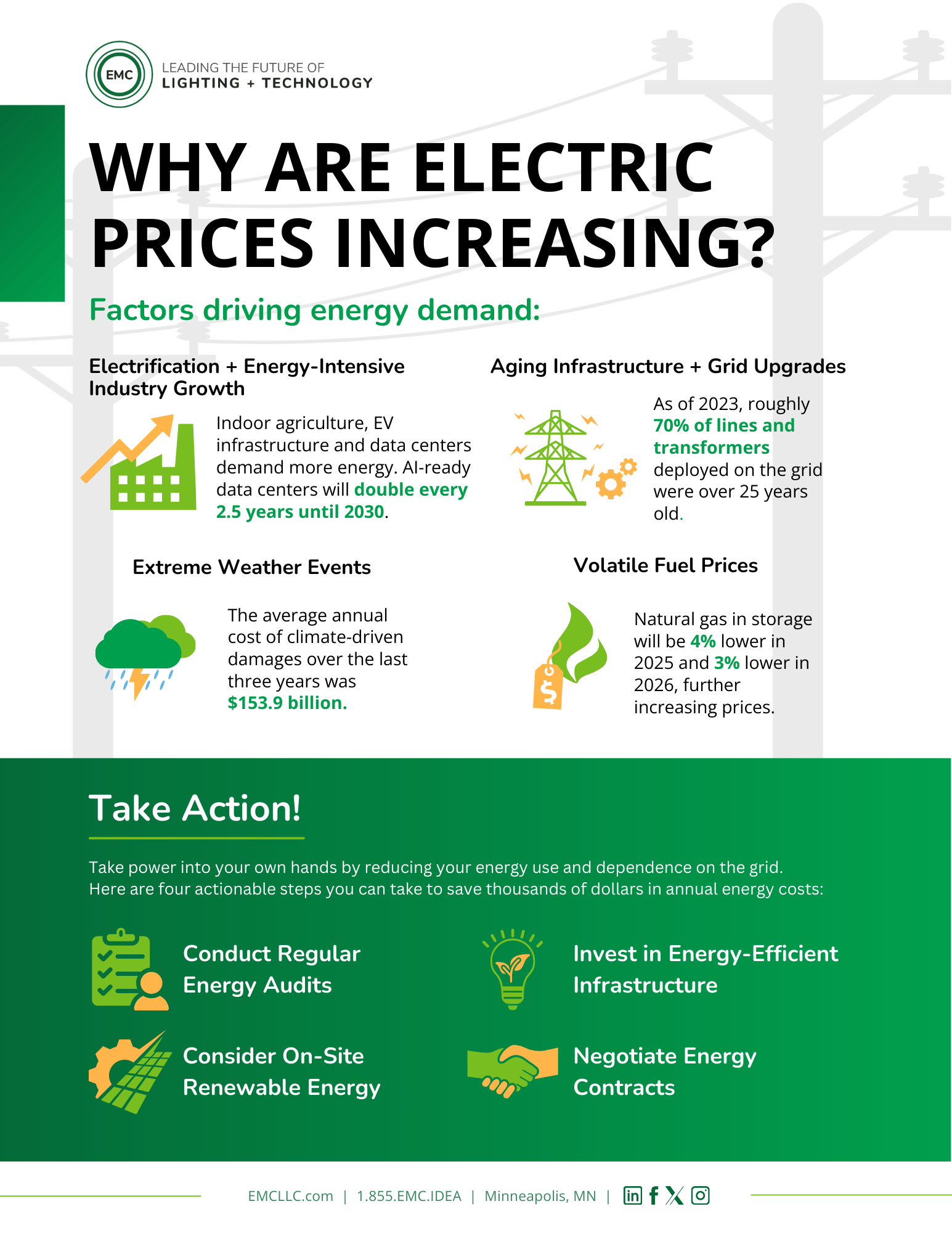Why Are Electric Prices Going up Faster Than Ever—With no End in Sight?

Image Source: eia.gov
We have effective strategies to help you mitigate cost increases.
As you can see, electric prices rose from 10.5 U.S. commercial cents per kWh to nearly 13 cents per kWh between 2020 and 2024. Based on every expert we rely on for solid information—including the Federal Energy Regulatory Commission, the Energy Information Agency, and NEMA (National Electrical Manufacturers Association)—that increase is predicted to continue. Some signs point to average annual $/KWh increase of 5-7% in some regions over the next several years.
In fact, estimated growth of peak demand by 2029 has changed from 23 gigawatts of use to 128 gigawatts within a few years, just based on a continual flood of new information concerning what’s going on in the marketplace. That’s the equivalent of adding 80 million homes to the power grid.
What is driving this increase?
Four major factors are causing energy costs to go up significantly:
- Rapidly increasing demand.
This includes indoor agricultural use such as cannabis growing and weather mitigation; creating infrastructure for EV charging; crypto server farms; electrification of heating and cooling systems; and huge data centers for crypto and AI that are currently expected to double every 2.5 years.
- The need to upgrade and replace an aging power grid.
As of 2023, roughly 70% of power lines and transformers used on the grid were more than 25 years old. And our current grid—both in terms of capacity and structural integrity— isn’t capable of handling all of the expected growth in energy use. This could add to the increase of 2-4% per year.
- The cost of extreme weather events.
The average annual cost of climate-driven damages to the electrical grid over the past three years was $153.9 billion.
- Rising natural gas prices.
Natural gas prices are expected to rise 2-3%, and that cost increase is exacerbated by the switch from generating electricity with coal to relying more on natural gas. Coal costs were fairly predictable, but natural gas prices have been far more volatile.
Who will be responsible for paying for these increases?
Will Public Utility Commissions allow producers to pass along all these increases to the end user? Residential rate payers may have some protections on their side, but the main growth for energy use is on the commercial side. So commercial and industrial customers will see rates go up, more than likely higher than at any other time in history. There is the possibility that utilities will decide to and be allowed to charge more to certain customers, such as AI data centers which use an inordinate amount of energy.
What can you do to weather this storm?
You can affect how much you use and when you use it. We have strategies that can help:
Benchmarking:
Do a thorough energy audit and then compare yourself against other similar buildings. Calculate your Energy Use Intensity (EUI), which is the Miles Per Gallon of your building’s energy use. You can work with an expert like EMC to handle the following to find out how well your building is operating:
- Conduct an onsite inventory of energy usage sources
- Measure energy usage
- Analyze your energy bills
- Analyze energy use patterns
Take control of your energy efficiency
Once you’ve discovered how much energy you’re using, when you’re using it, and where you can save, talk with us to develop a plan to reduce your costs as well as your risks. Saving enough energy is like owning your own power plant.
- Install UV-C coil cleaning to your HVAC system. You’ll get an initial savings of 10% with continuous improvement up to 15%.
- Implement Smart Building technologies. This allows you better visibility into how your buildings are operating. Smart controls can automate the heating, cooling and lighting for your building, saving you time and money. They can identify where energy is being wasted, and the difference they provide is most often imperceptible to occupants.
- Trade out traditional fluorescent lighting for LEDs. Fluorescents are becoming obsolete, and you soon won’t be able to buy replacement bulbs. If you already have LED lighting, we strongly urge you to do what we call a reLED retrofit if your system is more than seven years old to upgrade your current LEDs to a modern LED system. Changing to LEDs or doing a reLED can give you a one to three year ROI.
- Sign up for on-call peak reduction. Many utilities offer options for reduced use at the highest use times of day. This may consist of dimming the lighting, but it’s not enough for the human eye to detect. Adjust your indoor temperature, typically during the most extreme outdoor conditions. This won’t be noticeable either.
- Work from home. Then turn off lights and adjust thermostats when employees are working remotely.
What is the cost of waiting to make a change?
EnergyMAXX® can help you pay the minimum amount for your energy.
EMC’s total project management approach, EnergyMAXX®, maximizes the results of each project phase—from multi-site energy audits to utility rebate and incentive savings—to bring a positive impact to your bottom line.
Our turnkey approach provides a predictable, transparent project management process that ensures everyone is kept apprised on what objectives we’re working to meet and up to date on what outcomes have been achieved every step of the way:
With EnergyMAXX® you’ll be able to:
- Prioritize projects within your retrofit using EUI and budgetary benchmarks
- Use a thorough audit to confirm opportunities
- Design the right approach to your retrofit by developing options
- Maximize any available incentives
- Manage logistics to help coordinate labor and materials
- Ensure proper installation employing our 7500+ trained technicians
- Minimize long-term ownership cost using third-party service
Working with EMC and EnergyMAXX® allows you to scale your projects across hundreds and thousands of sites.
Kris Leaf is EMC’s Senior Manager of Customer Incentives. The job includes following a range of policies that affect and promote excellent energy performance in buildings. He developed some of the first programs in the country to promote the construction of energy efficient commercial buildings – many of which are still used by utilities like Xcel Energy, ComEd, Duke Energy and others. Kris is a LEED Accredited Professional. He has degree in Mechanical Engineering from the University of Minnesota and in his spare time is pursuing a Masters in Sustainable Business from the University of Wisconsin.



